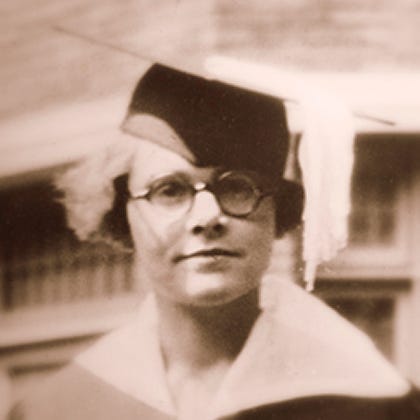Barbara McClintock - The noble at 81
Barbara McClintock was born Eleanor McClintock on June 16, 1902. When she was a young girl, her parents determined that Eleanor, a "feminine" and "delicate" name, was not appropriate for her, and chose Barbara instead. McClintock was an independent child beginning at a very young age, a trait she later identified as her "capacity to be alone".
Nothing says trouble like a woman in pants. That was the attitude about women in the 1930s anyway; when she started working at the University of Missouri. She was called the troublemaker because she worked late with students, who were breaking the curfew. She was feisty, spunky, direct, and worked in her own ways to get the result that she wanted, which you would consider great for someone who is a scientist. But, back then a woman who was intelligent, self-confident, had a willingness to break the rules, and of course, who wore pants were considered shocking!!!
McClintock observed by studying successive generations of maize plants, instead of being locked into place giving fixed instructions from generation to generation, some genes could move around or “transpose” within chromosomes, switching physical traits on or off according to certain “controlling elements.”
Barbara McClintock didn’t come from a wealthy background, which makes it all the more remarkable that she went to university and devoted her life to research. She obtained her PhD. from Cornell University. During graduate school, she began the work that would occupy her entire professional life: the chromosomal analysis of corn (maize).
She was already well known for her groundbreaking work on mapping of corn chromosome at Cornell. But, her intelligence became a threat to some of her male counterparts at Missouri and she was even threatened by the dean that if she got married she would have to leave the job, or even if her male partner left the research she would have to do the same. Later she was ignored by board members and not called for meetings. Realizing that she would never get equal status and right at Missouri she left, in search of a place where her passion was recognized and a place where she could freely work her research.
This place was at Cold Spring Harbor, New York, where McClintock began to study the mosaic colour patterns of maize at the genetic level. She had noted that the kernel patterns were too unstable, and changed too frequently over the course of several generations, to be considered a mutation. What was responsible for this? The answer contradicted prevailing genetic theory.
Labelled maize. Barbara McClintock discovered
that gene could "jump" by studying generational
mutations in maize.
She knew that the result of her work was different from something that the masses believed and it would be challenging to make them believe the fact that genes are not stagnant yet she never gave up and continued giving lectures on transposition. But contrary to her efforts nobody believed her. But she never minded because as she said - "when you know you're right, you don't care."
But, finally in the 1960s when the lac operon theory was put forward that was the time that the scientific community started coming to the same conclusion as her and started validating her transposon or jumping gene theory, which was long overdue. After 30 years of her work, she received the Noble peace prize at the age of 81. She never got married and had no children and till her last days kept working.
Beyond her discoveries, though, McClintock’s legacy is one of uncommon persistence. As she put it, “If you know you are on the right track if you have this inner knowledge, then nobody can turn you off... no matter what they say.”
This was the story of the cytogeneticist Barbara McClintock. She paved the way for so many women. From her story, I learned that it doesn't matter if anyone believes in you or not up until you believe in yourself. This women's day let's take her example and teach and encourage the women and also men around us to be persistent and to believe in one's passion and work towards it no matter what the people around say. Who knows maybe she/he becomes someone whom the world will remember for her/his contribution for ages. What did you learn from this story? let me know down in the comments and share this story with people because sometimes it's just one story that changes life.
(Thank you, everyone, for showing so much love to my last blog. I am really so grateful for your support.)










Comments
Post a Comment